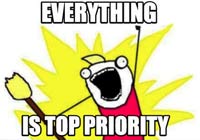It is pretty easy to be mad while at work. I learned that early on in my career. Lots of things made me furious and I took it upon myself to self-righteously attempt to address each and every one of them. I cannot stress enough what a bad idea this is. Every once in a while you will take the thing you are angry about and wrestle it to the ground. The vast majority of the time you will be sitting alone in the burned out wreckage of the battle you just “won” wondering what exactly just happened.
I am about to share one of the biggest things I have learned professionally over two decades:
If you are going to be mad at something please be mad at the right thing.
Dear students, welcome to Compartmentalization 101.
Before I get into this I want to state that the vast majority of things that make you mad at work should not make you mad at all. I think that was probably the first thing I did wrong. I got mad at just about everything.
Don’t like other people’s buggy code? Get mad. Don’t like being told your feature is not a priority? Get mad. Don’t like that your recommendation to change to a more scalable server platform got rejected without justification? Get mad. You can clearly see the pattern.
Any time you find yourself mad at work, you probably should take a step back and ask yourself “should I really be mad at this?”
I assure you the majority of the time that answer should be a firm and resounding NO.
These days it takes quite a lot at work to make me mad at a situation or at a person. I will not say that it does not happen. Most of the time it happens I can catch myself before doing something dumb about it.
This is why I urge people to learn to compartmentalize their emotions at work. If you are going to get angry at work you should understand why you are angry and what you are really angry about.
If you can get to a solid place of self-reflection you will find that when you are angry at something at work you are often angry at the wrong thing. This happens quite a bit with customer service. When I have a problem with my bank or my credit card that makes me angry, I am very apologetic to the person on the phone because I want them to understand that I am not mad at them—I am mad at the situation. I think that so many people take out their frustrations on these poor customer service people that they appreciate the heartfelt acknowledgement and it feels like they are more willing and able to help me get to a good outcome accordingly.
So how can you find out what you are really mad about?
I am very sorry. I do not have any magical ideas here to help with that. It will take a lot of practice.
The best place to start is to take a look at things that you do while you are angry. If you can get in front of those with some self-reflection, that is a good first step. It is also a very important one.
If you are angrily getting into conversations or angrily writing emails, you are probably going to create drama, tension, and unfortunate outcomes—especially if you are angry at the wrong thing.
I find that the time I slip up with this the most is before I am done my first cup of coffee in the morning. I am not yet fully engaged with my plan for the day and not yet fully caffeinated. I try to spend the mornings doing a little information absorption from the world around me while getting started with my day, and it helps get me into a positive mental framework. Because I am reading and thinking, I am also not grumpily digging into things or starting angry conversations. If you find yourself starting off the day blowing stuff up all around you, I strongly suggest you consider switching your day to input-mode like I do.
There are two other things that I do that help me catch myself when I am about to do something angry.
The first is to start off my emails with something like “I apologize for the delay” or “I appreciate your time”. The cognitive dissonance of trying to write that statement while angry is nearly comical. The other one is to end as many of my emails as possible by typing “Warm regards”. It has the same effect.
The additional side effect of the latter statement is that people who receive many of my emails directly or indirectly will see this. At least once a year someone will notice when it has been omitted from an email and they know that I am in a place that is either concerned or angry. I appreciate hearing from someone when they see I have left off my “warm regards”.
It is harder to get in front of an angry conversation. Being able to catch yourself in the moment takes a considerable amount of self-awareness. I would say that there is some significant percentage of time that I do not realize I am in an angry conversation until after I have already started digging into something aggressively.
I generally become self-aware about it before the conversation is over and then I have to stop, back up, and acknowledge it to the participants.
This is another good thing to do. If you cannot catch yourself before doing something angry you should be able to catch yourself consistently in the middle of doing something angry.
I am happy to be on the receiving end of gentle mockery and good natured ribbing after having a mea culpa moment. If I can get to a place of saying “Hey folks, I just realized I am angry about this situation and I should not be. Let’s back up a second here and discuss what the problem is,” then I am more likely to get to a good outcome. It will certainly be a better outcome than if you get into a meeting, proceed to set everything on fire, and then storm out of the room smelling of tears and ashes. I, um, may know someone who was good at that.
So why is it important to process your anger in this way?
For starters, you are probably angry at the wrong thing. You just cannot see it because you are angry. I have found myself angry at people when I should have been angry at situations, and angry at situations that have been created by people.
Identifying what you are really angry at is hard. It is very easy to be angry at people. Ironically, the more easily you get mad at someone, the less likely they are the reason you are angry. Unpacking deeply layered sources of frustration is a fine art and even twenty years into your career you might not realize the grand sum of all the frustrations you are carrying. Quite often you are just lashing out at the most recent thing added to a giant pile of frustrations.
If you can get to the place where you can identify when you are angry at work, and then start unpacking the things you are really angry about, that is a good place to be.
In addition to being angry at the wrong thing plenty of times myself, I have observed it in other people and generally make an effort to unpack what they are angry about. I will try two to three times per person to try to help them see past that and unpack what they are really angry about.
Being able to reduce the amount of things you are angry about and the amount of times you are angry at the wrong thing is an important part of transcendent career changes.
I am grateful that I have grown past the vast majority of things that made me angry, even if it took me a long time to do that.
If you find that you self-identify with this post, you might have some of the same problems early in your career that I did. Now I will tell you why it took me a long time to fix them.
For starters, if you are angry about things, then people are going to avoid you. Especially if you are angry about the wrong things. You can swiftly make yourself persona non grata on your team by constantly lashing out and constantly blowing up. When I first became painfully self-aware of how much I was angry at random things, I was immediately irritated that no one helped me with that. In hindsight I understand it better because I had a very large blast radius. There was a high probability that someone trying to set me on the road to self-improvement would have accidentally set off some kind of chain reaction and have been on the receiving end of some of the damage.
The second thing to mention is that angry people are also very easy to manipulate into a box. The worst boss I have ever had was pretty good at yanking my chain and getting me to do angry things as a default behavior. While you always want to give your boss and your leaders the benefit of the doubt and do your best to do things to help, sometimes you find that out after the fact that you were being set up for failure to advance someone else’s goals. I have not ran into this many times in my career but I have ran into it enough times that I know it when I see it and I know to control my reactions far better when being told to go dance blindly in the minefield while other people are clapping and cheering.
So there you have it.
Please do not get mad at work.
If you are going to get mad at work, you had better be mad at the right thing.
If you are mad at work and mad at the wrong thing, you are likely going to find yourself lonely in the best case, and weaponized by others in the worst case.
I wish I had some more concrete steps to help you get there from here. There are so many things that happened around the time that I started calming down professionally that I cannot really ascribe causality to any one of them.
If you find yourself in this situation, you might find you are going to hit a professional ceiling at work. Of course the instant you get made aware of that, I am expecting that you will probably be angry, and probably at your boss who did not promote you.
Which begs the question: Did you even read this article?
Heyooo!
Please share this article with your friends. Especially if you think it will make them angry.
If you just got this article from a friend and were angry at them up until this sentence, please send them a thank you note. They are probably trying to tell you something you don’t want to hear.
That is the article today. Over the past month I have managed to find another half a dozen topics working with a few people who have asked for professional mentoring. If this is something that you are interested in, please reach out. This is absolutely a shameless sales pitch.









